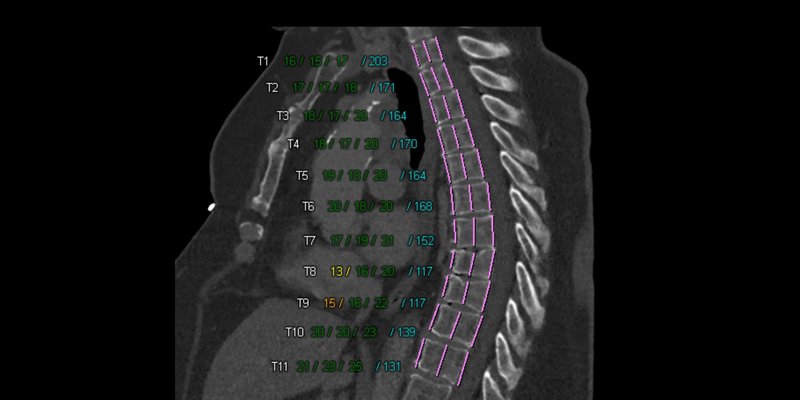
Company: Siemens Healthineers Product: AI-Rad Companion Chest CT
Artificial intelligence for opportunistic osteoporosis screening with a Hounsfield Unit in chronic obstructive pulmonary disease patients
Journal of Clinical Densitometry: Assessment & Management of Musculoskeletal Health, 2025
Abstract
Introduction
To investigate the accuracy of an artificial intelligence (AI) prototype in determining bone mineral density (BMD) in chronic obstructive pulmonary disease (COPD) patients using chest computed tomography (CT) scans.
Methodology
This study involved 1276 health checkups and 1877 COPD patients who underwent chest CT scans from April 2020 to December 2021. Automated identification, segmentation, and Hounsfield Unit (HU) measurement of the thoracic vertebrae were performed using the musculoskeletal module of the AI-Rad Companion Chest CT (Siemens Healthineers, Er langen, Germany). Patients were divided into three groups: normal BMD, osteopenia, and osteoporosis, with quantitative CT (QCT) as the standard for analysis. The correlation between the HU and BMD values from T8 to T12 and T11-T12 vertebrae was analyzed using Linear regression analysis. The diagnostic performance of the HU values from T8 to T12 and T11-T12 vertebrae for osteoporosis was evaluated using the receiver operating characteristic curve.
Results
The HU values strongly correlated with BMD values in health checkups and COPD patients (R2=0.881‒0.936 and 0.863‒0.927, P < 0.001). The Box-and-Whisker plot showed significant differences between HU and BMD values for T11-T12 vertebrae in normal BMD, osteopenia, and osteoporosis groups in two datasets (P < 0.001). The AUC was 0.970-0.982 and 0.944-0.961 in health checkups and COPD patients for detecting osteoporosis, with a sensitivity of 92.27 %‒97.42 % and 79.48 %‒90.24 % and a specificity of 86.35 %‒92.69 % and 82.81 %‒90.94 %. The optimal thresholds were 99.5‒120.5 HU and 104.5‒123.5 HU, respectively.
Conclusions
The AI software achieved high accuracy for automatic opportunistic osteoporosis screening in COPD patients, which may be a complementary method for quickly screening the population at high risk of osteoporosis.
Read full study